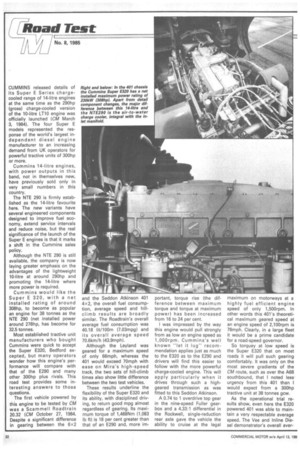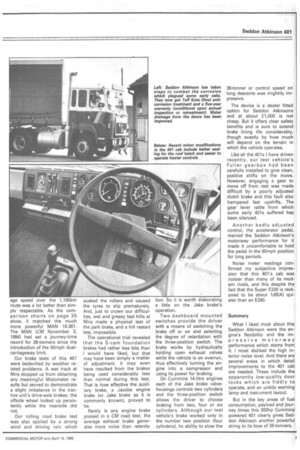CUMMINS released details of its Super E Series chargecooled range
Page 34

Page 35

If you've noticed an error in this article please click here to report it so we can fix it.
of 14-litre engines at the same time as the 290hp (gross) charge-cooled version of the 10-litre LT10 engine was officially launched (CM March 3, 1984). The four Super E models represented the response of the world's largest independent diesel engine manufacturer to an increasing demand from UK operators for powerful tractive units of 300hp or more.
Cummins 14-litre engines, with power outputs in this band, not in themselves new, have previously sold only in very small numbers in this country.
The NTE 290 is firmly established as the 14-litre favourite here. The new variants have several engineered components designed to improve fuel economy, extend service intervals and reduce noise, but the real significance of the launch of the Super E engines is that it marks a shift in the Cummins sales policy.
Although the NTE 290 is still available, the company is now laying greater emphasis on the advantages of the lightweight 10-litre at around 290hp and promoting the 14-litre where more power is required.
Cummins would like the Super E 320, with a net installed rating of around 308hp, to become as popular an engine for 38 tonnes as the NTE 290 (net installed power around 278hp, has become for 32.5 tonnes.
Most established tractive unit manufacturers who bought Cummins were quick to accept the Super E320, Bedford excepted, but many operators wonder how this engine's performance will compare with that of the E290 and many other 300hp plus rivals. This road test provides some interesting answers to those questions.
The first vehicle powered by this engine to be tested by CM
was a Scammell Roadtrain 20.32 (CM October 27, 1984. Despite a significant difference in gearing between the 6x2
and the Seddon Atkinson 401 4X2, the overall fuel consumption, average speed and hillclimb results are broadly similar. The Roadtrain's overall average fuel consumption was 40.18 lit/100m (7.03mpg) and its overall average speed 70.6km/h (43.9mph).
Although the Leyland was geared for a maximum speed of only 66mph, whereas the 401 would exceed 70mph with ease on Mira's high-speed track, the two sets of hill-climb times also show little difference between the two test vehicles.
These results underline the flexibility of the Super E320 and its ability, with disciplined driving, to return good mpg almost regardless of gearing. Its maximum torque of 1,468Nm (1,083 lb ft) is 18 per cent greater than that of an E290 and, more im portant, torque rise (the difference between maximum torque and torque at maximum power) has been increased from 16 to 24 per cent.
I was impressed by the way this engine would pull strongly from as low an engine speed as 1,000rpm. Cummins's well known "let it lug" recommendation applies just as much to the E320 as to the E290 and drivers will find this easier to follow with the more powerful charge-cooled engine. This will apply particularly when it drives through such a highgeared transmission as was fitted to this Seddon Atkinson.
A 0.74 to 1 overdrive top gear in the nine-speed Fuller gearbox and a 4.33:1 differential in the Rockwell, single-reduction rear axle gave the vehicle the ability to cruise at the legal maximum on motorways at a highly fuel efficient engine speed of only 1,500rpm. In other words this 401's theoretical maximum geared speed at an engine speed of 2,100rpm is 78mph. Clearly, in a large fleet it would be a prime candidate for a road-speed governor.
So torquey at low speed is the Super E320 that on most roads it will pull such gearing comfortably. It was only on the most severe gradients of the CM route, such as over the A68 southbound, that I noted less urgency from this 401 than I would expect from a 300hp tractive unit at 38 tonnes gcw.
As the operational trial results show, even here the E320 powered 401 was able to maintain a very respectable average speed. The Vee and Inline Diesel demonstrator's overall aver age speed over the 1,185km route was a lot better than simply respectable. As the comparison charts on page 35 show, it matched the much more powerful MAN 19.361. The MAN (CM November 3, 1984) had set a journey-time record for 38-tonners since the introduction of the 50mph dualcarriageway limit.
Our brake tests of this 401 were bedevilled by weather related problems. A wet track at Mira stopped us from obtaining any meaningful Motometer resuits but served to demonstrate. a slight imbalance in the tractive unit's drive-axle brakes; the offside wheel locked up persistently while the nearside did. not.
Our rolling road brake test was also spoiled by a strong wind and driving rain which soaked the rollers and caused the tyres to slip prematurely. And, just to crown our difficulties, wet and greasy test hills at Mira made a physical test of the park brake, and a hill restart test, impossible.
The operational trial revealed that the S-cam foundation brakes had rather less bite than I would have liked, but that may have been simply a matter of adjustment. It may even have resulted from the brakes being used considerably less than normal during this test. That is how effective the auxiliary brake, a Jacobs engine brake (or Jake brake as it is commonly known), proved to be.
Rarely is any engine brake praised in a CM road test; the average exhaust brake generates more noise than retarda tion. So it is worth elaborating a little on the Jake brake's operation.
Two dashboard mounted switches provide the driver with a means of switching the brake off or on and selecting the degree of retardation with the three-position switch. The brake works by hydraulically holding open exhaust valves while the vehicle is on overrun, thus effectively turning the engine into a compressor and using its power for braking.
On Cummins 14-litre engines each of the Jake brake valvehousings controls two cylinders and the three-position switch allows the driver to choose braking from two, four or six cylinders. Although our test vehicle's brake worked only in the number two position (four cylinders), its ability to slow the 38-tanner or control speed on long descents was mightily impressive.
The device is a dealer fitted option for Seddon Atkinsons and at about £1,000 is not cheap. But it offers clear safety benefits and is sure to extend brake lining life considerably, though exactly by how much will depend on the terrain in which the vehicle operates.
Like all the 401s I have driven recently, our test vehicle's Fuller gearbox had been carefully installed to give clean, positive shifts on the move. However, engaging a gear to move off from rest was made difficult by a poorly adjusted clutch brake and this fault also hampered fast upshifts. The gear lever rattle from which some early 401s suffered has been silenced.
Another badly adjusted control, the accelerator pedal, marred the Seddon Atkinson's motorway performance for it made it uncomfortable to hold the pedal in the 60mph position for long periods.
Noise meter readings confirmed my subjective impression that this 401's cab was noisier than many of its modern rivals, and this despite the fact that the Super E320 is reckoned to be about 1dB(A) quieter than an E290.
Summary What I liked most about this Seddon Atkinson were the engine's flexibility and the impressive motorway performance which stems from it. I most disliked the high interior noise level. And there are several areas in which detail improvements to the 401 cab are needed. These include the apparently low-quality door locks which are fiddly to operate, and an untidy warning lamp and instrument layout.
But in the key areas of fuel consumption, payload and journey times this 300hp Cummins powered 401 clearly gives Seddon Atkinson another powerful string to its bow of 38-tonners.




















































































